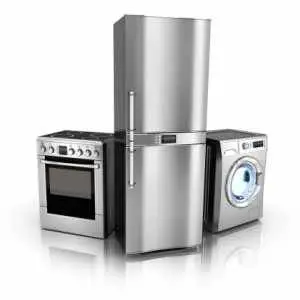The Top 5 Major Home Appliance Brands in the World
| Brand (company name) |
Country | Net Sales | Percent Change | |
|---|---|---|---|---|
| 1 | Haier (Haier Group) |
China | $25.8 billion | + 8.1% |
| 2 | Whirlpool (Whirlpool Corp.) |
United States | $18.1 billion | - 2.8% |
| 3 | Electrolux (AB Electrolux) |
Sweden | $16.2 billion | + 8.3% |
| 4 | Gree Electric (Gree Electric Appliances Inc.) |
China | $15.7 billion | + 19.4% |
| 5 | BSH Bosch & Siemens (BSH Hausgeräte GmbH) |
Germany | $12.6 billion | +1.5% |
 Special Report
Special Report
Home Appliances a Growth Market in the Pandemic Age?
The impact of the global economic recession was forecasted to cause global shipments of home appliances to fall by 8% in developed or "mature" regions . Countries in Western and Eastern Europe were projected to see the steepest drop in appliance shipments while Latin America, Africa, and parts of Asia were set to outperform the global average. (a.)
The market for semiconductors in major home appliances will grow to over $1.5 billion by 2013 as penetration of displays, touch controls, and variable speed motor control rises. The home appliance Market was expected to grow into 2026 as emerging middle classes in developing countries such as Africa, The Middle East, Eastern Europe, Latin America, Southeast Asia, and China buy or rent more homes. It is still unsure how Sars-cov-2 will affect this growth as of July 2020. The North American market is considered to be a "mature" market for household electrical appliances because it is mainly seen by the large manufacturers as a "replacement" product market. Many large appliance manufacturers are focusing on repair and service in these markets. (a., d.)
Euromonitor International's rankings place Haier's refrigeration appliances and Haier's home laundry appliances first by global brand name, with 10.4% and 8.4% retail volume market share respectively, up 3.7 point and 1.5 point from 2008. (b.)
In 2019 in China the total revenue of home appliance companies such as Haier reached about $226 billion U.S. dollars. On the one hand, players launched low-end brands to attract price-sensitive consumers. On the other, increased living standards continued to drive up demand for small appliances in Chinese households. Niche products such as tabletop ovens experienced remarkable growth over the review period. Compared with the lacklustre performance in mass market large kitchen appliances, high-end refrigerators and washing machines saw robust growth in urban areas in China. More players had their eye on exploring the high end of the market, and concentrated on developing premium products such as side-by-side or three-door refrigerators, and tumble drum washing machines. This trend is in line with rising disposable incomes and increasing consumer sophistication. (b.)
Despite the federal government's attempts to spur banks to lend and to provide incentives for first-time home buyers, the number of new homes purchased fell in 2009 for the third consecutive year. While the average unit price of small appliances is far lower than that of major appliances, rising unemployment levels and the consequent declines in household discretionary incomes contributed to declines in volume and value sales of the small appliances industry. The two largest manufacturers of major appliances in the US, Whirlpool Corp and General Electric Co (GE), both unveiled some of their plans to manufacture their appliances to be smart-grid compatible. Smart appliances are able to ascertain when energy use is at its peak and therefore delay their function until energy use has fallen. While both of these companies cite 2015 as a target for when their appliances will all be manufactured with smart technology, smart meters as well as pricing structures for peak and non-peak energy times are still needed to make this a reality in the US. (c.)
The global market for household appliances can be split into two basic regions for manufacturers. In the mature markets: Western Europe, North America, Japan and Australia/New Zealand, population growth is low and sales are dominated by replacement products as people replace their aging appliances. However, growth markets such as Africa, the Middle East, Eastern Europe, Latin America, Southeast Asia and China are characterized by rapidly rising living standards and a large number of new households being able to invest in appliances and other household products.
During the period of 2016 - 2019, demand for appliances increased in mature markets as a number of growth trends are predicted until 2026 such as increased consumer power, digitalization, sustainability,consolidation and a growing middle class in developing countries, however at this time large manufacturers are dealing with the aftereffects of a global shutdown from the Coronovirus pandemic which may affect the accuracy of growth predictions that were made before March, 2020.
Top 5 facts sources: A. IMS Research. (2009). "The World Market for Major Home Appliances". Retrieved October 23, 2010. B. Euromoniter International. (2010). "Consumer Appliances in China". Retrieved October 23, 2010. C. Euromoniter International. (2010). "Consumer Appliances in the US". Retrieved October 23, 2010. D. Electrolux Annual Report. (2016).
Sources: Deloitte Report: Global Powers of Consumer Products 2014.
List Notes: Data is the top 5 Home Appliance Brands in the World for the fiscal year 2012 ranked according to global sales. All figures are in U.S. dollars. Data is latest available as of July, 2020.
Please note: this list includes home appliance brands only (washers, dryers, refrigerators, stoves etc) and does not include home electronics brands (televisions, PCs, Audio and visual equipment etc). Euromonitor International.

